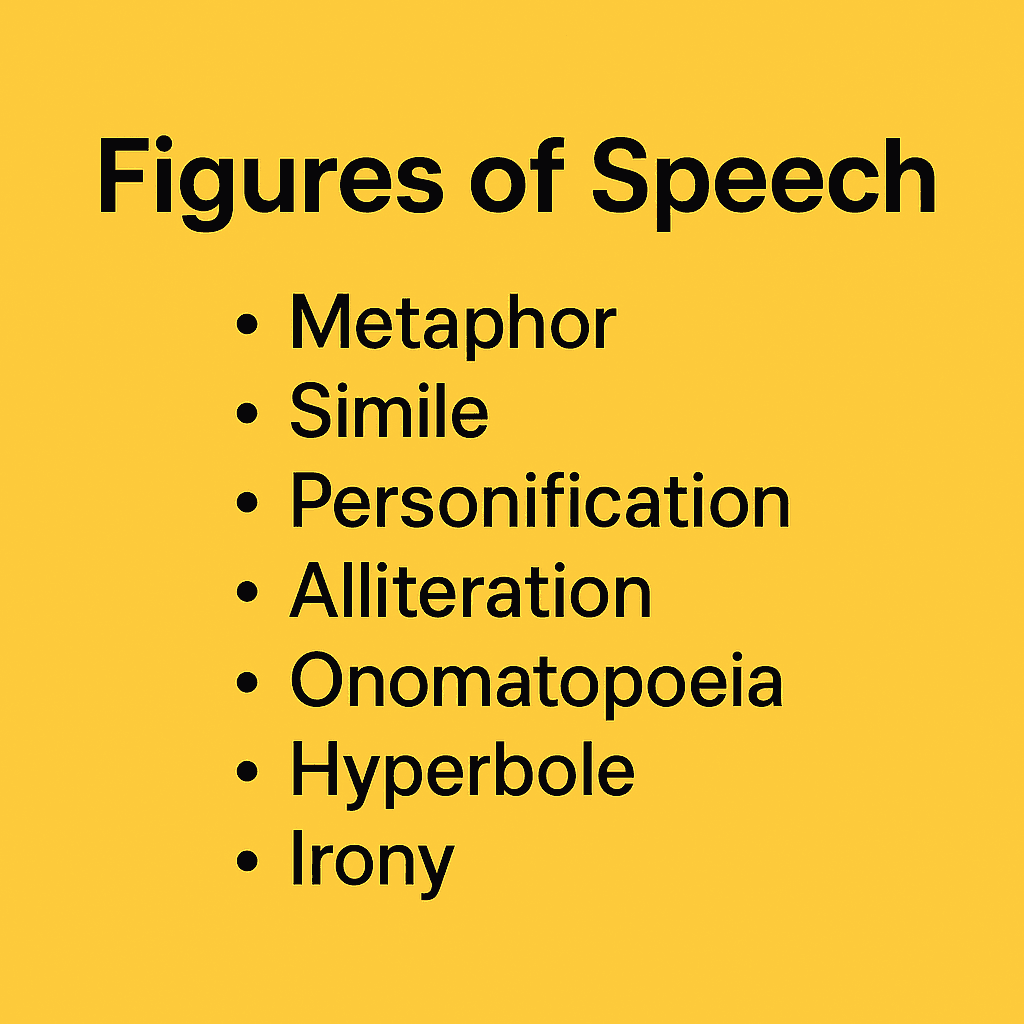English - Figures of Speech
Concept-focused guide for English -Figures of Speech.
~6 min read

Overview
Welcome! In this learning article, we’ll demystify the most common figures of speech found in English—those creative twists that enliven everyday language and poetry. By the end, you’ll confidently recognize, distinguish, and interpret similes, metaphors, personification, alliteration, onomatopoeia, hyperbole, and irony in any context. We’ll break down each concept, walk through sample scenarios, and highlight common traps to help you ace your quiz and use these features in your own writing.
Concept-by-Concept Deep Dive
Metaphor
What it is:
A metaphor is a direct comparison between two unrelated things to highlight a shared quality, without using "like" or "as." It transforms one thing into another to create vivid imagery or deep meaning.
Components/Subtopics:
- Vehicle: The image or idea that the subject is compared to.
- Tenor: The actual subject being described.
Reasoning Recipe:
- Spot the subject and what it’s being compared to.
- Check if the comparison is direct (no “like” or “as”).
- Analyze what quality is shared or transferred.
Common Misconceptions:
- Confusing metaphors with similes (look for “like” or “as”—those indicate similes).
- Thinking metaphors must be logical; often, the power comes from their creative leap.
Simile
What it is:
A simile is a figure of speech that compares two different things using connecting words such as “like” or “as.” It draws a resemblance to clarify or emphasize a trait.
Components/Subtopics:
- Connector: The word “like” or “as” signals a simile.
- Comparison: The two elements being compared.
Reasoning Recipe:
- Search for “like” or “as” in the sentence.
- Identify what’s being compared.
- Consider how the comparison deepens the meaning or imagery.
Common Misconceptions:
- Missing subtle similes that use less obvious comparisons (e.g., “as quick as a flash”).
- Assuming that all use of “like” or “as” indicates a simile—even if there’s no real comparison.
Personification
What it is:
Personification gives human traits, feelings, or actions to non-human things, animals, or abstract ideas. It’s often used to make descriptions more vivid or relatable.
Components/Subtopics:
- Non-human subject: Often an object, animal, or idea.
- Human attribute: An action or feeling normally associated with people.
Reasoning Recipe:
- Identify what is being described.
- Ask: Is this thing capable of human actions or feelings?
- If not, and it’s described as doing something human, it’s personification.
Common Misconceptions:
- Mistaking literal references to animals or people as personification.
- Overlooking subtle uses, such as emotions or intentions assigned to objects or nature.
Onomatopoeia
What it is:
Onomatopoeia is when a word’s sound imitates the noise or action it describes (like “buzz,” “clang,” or “whisper”). It makes writing more expressive and sensory.
Components/Subtopics:
- Sound word: The term itself mimics the sound.
Reasoning Recipe:
- Look for words that sound like what they describe.
- Ask: If you say the word aloud, does it resemble a sound you recognize?
Common Misconceptions:
- Confusing onomatopoeia with interjections (not all interjections are sound-imitative).
- Thinking any descriptive word is onomatopoeia—only those that echo real sounds qualify.
Alliteration
What it is:
Alliteration is the repetition of the same initial consonant sound in closely connected words. It’s often used for rhythm, mood, or emphasis.
Components/Subtopics:
- Repeated sound: Usually at the start of several words in a row or nearby.
- Effect: Creates musicality or draws attention.
Reasoning Recipe:
- Read the sentence aloud and listen for repeating initial sounds.
🔒 Continue Reading with Premium
Unlock the full vlog content, professor narration, and all additional sections with a one-time premium upgrade.
One-time payment • Lifetime access • Support development
Join us to receive notifications about our new vlogs/quizzes by subscribing here!